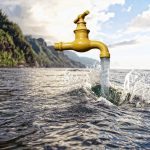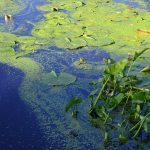 Maintaining the health of fish and plants is directly related to the quality of the water in which they live and grow. Most people assume that because their tap water is clean and clear that it is suitable for fish and plants. This is a major misconception. Tap water is usually filled with chlorine and/or chloramines and other toxins that should be tested for prior to adding fish and plants to your pond. Water conditions can be determined by testing for pH, ammonia, nitrite, and salt. It is also a good idea to test for nitrate and KH as well.
Maintaining the health of fish and plants is directly related to the quality of the water in which they live and grow. Most people assume that because their tap water is clean and clear that it is suitable for fish and plants. This is a major misconception. Tap water is usually filled with chlorine and/or chloramines and other toxins that should be tested for prior to adding fish and plants to your pond. Water conditions can be determined by testing for pH, ammonia, nitrite, and salt. It is also a good idea to test for nitrate and KH as well.
Most people that already have a pond understand the importance of water quality. However, new pond owners don’t understand the importance and need to be educated prior to them adding fish and plant life to their ponds. Most problems begin right from the tap. Tap water is full of disinfectants like chlorine and chloramines that are very toxic to pond life. Tap water often contains many heavy metals as well. Let’s discuss the appropriate parameters for suitable fish and plant pond water.
Your municipal water supply adds different water conditioners, mainly chlorine and chloramines, to remove the harmful substances in the water supply. The chlorine, if left untreated, will dissipate after a few days. However, during this time the chlorine will destroy gill tissue, cause stress on the fish, and can cause suffocation. Damage tissue prevents normal respiration, impairing the uptake of oxygen and the release of ammonia and carbon dioxide from the fish’s blood. Chloramines are a combination of chlorine and ammonia. Unlike chlorine, chloramines last longer and will stay in the pond for weeks. The chloramines, if left untreated, pass through the gills and enter the bloodstream, preventing the blood from carrying oxygen and suffocating the fish. Whether added for evaporation or a water change, tap water should be treated with a product that eliminates both chlorine and chloramines.
Fish require electrolytes for their metabolic processes. The electrolyte content in tap water is often lower than their natural habitats. You can measure the electrolyte level very easily with a salt level test kit. The addition of Pond Salt (plain NaCl or sea salt) replenishes missing electrolytes and should be added to a level of 0.1% for a water garden containing fish and plants and 0.3-0.6% for a fish-only pond. Do not use iodized table salt as this can be fatal to your pond fish.
The pH of the water is a measurement of acidity and ranges from 0 to 14. Below 7 is acidic, 7 is neutral, and above 7 is alkaline. In a pond pH will fluctuate due to carbon dioxide levels in the water. Carbon dioxide from fish metabolism, plant respiration, mineral acids from pollution, organic acids from decaying debris, and impurities leached into tap water all lower pH. Slight pH variations will not harm fish, if they do not go too low or too high. Koi and goldfish, however, prefer a pH between 6.8 and 8.0.
Alkalinity is the ability of water to resist (buffer) changes in pH. Alkalinity (also known as Carbonate Hardness or KH) is the measure of carbonate and bicarbonate ion concentrations. These minerals are present in all tap water regardless of their source. An alkalinity value of 50 to 200 ppm is good. These levels provide greater buffering and more stable pH. If alkalinity is less than 50 ppm then wide pH swings are common.
The upper and lower lethal limits for any substance affecting fish are not fixed but often vary depending on other pond conditions such as temperature, metal concentrations, pH level, ammonia level, and oxygen level. For example, the wider the pH swing the more susceptible fish are to other environmental conditions leading to disease and possibly death.
Ideally, the water in the pond should be clean and clear. But the reality is that pond water is constantly being polluted and is changed only periodically. In between water changes, pollution can reach harmful levels, causing the water quality to decline to a point where it inhibits the growth of fish and weakens their immune systems, and often decreases plant growth. If the water quality is not good, both fish and plants will suffer and algae will flourish.
Here’s the answer to some common questions about water quality:
Doesn’t algae indicate unhealthy water?  Not necessarily. Crystal clear water may still have dangerously high levels of some substances. And vice versa, algae may be present in pond with good water quality. Though unsightly, algae doesn’t always indicate poor water quality.
Not necessarily. Crystal clear water may still have dangerously high levels of some substances. And vice versa, algae may be present in pond with good water quality. Though unsightly, algae doesn’t always indicate poor water quality.
Can I add table salt to my pond? Only plain salt or sea salt should be used. Some table salt has iodine added, which can be harmful to fish.
Why do pH test results vary greatly throughout the day in the same pond? Rising carbon dioxide levels in the water from fish metabolism and debris, will lower the pH. Ponds with plants, including algae, use carbon dioxide during the day and release it at night causing changes to the pH at different times of the day.
Should I treat the tap water when topping off my pond? Yes. The chlorine and chloramines harm fish, even in small amounts. This is effect is cumulative and permanent so you should always treat the water with a product that removes both the chlorine and chloramines.
Why should I test the water? The only sure way to check for harmful substances is by testing the water. You cannot tell by looking at a pond whether it has healthy water conditions or not. By the time a pond reacts with visible indicators it may be too late to correct the problems. Regular testing is the best way to prevent problems from arising.

















